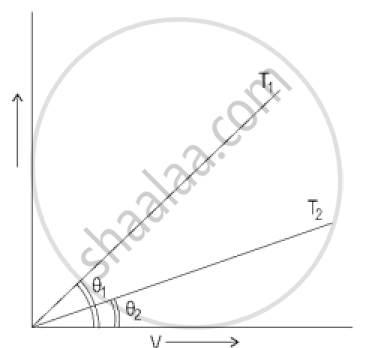Advertisements
Advertisements
प्रश्न
Can the peak voltage across the inductor be greater than the peak voltage of the source in an LCR circuit?
उत्तर
Let a LCR circuit is connected across an AC supply with the emf E = E0 sin ωt.
Let the inductance in the circuit be L
Let the net impedence of the circuit be Z = `sqrt(R^2 + (X_L -X_c)^2`
Where,
R = resistance in the circuit
XL = reactance due to inductor
XC = reactance due to capacitor
The magnitude of the voltage across the inductor is given by
`V = L(di)/(dt)`
The current in the circuit can be written as `I = I_0 sin (wt + Ø)`
Where, ϕ is the phase difference between the current and the supply voltage
Thus, the voltage across the inductor can be written as
`V = LI_0`
⇒ `V = (E_0)/(Z)xxL,`
Therefore, the peak voltage across the inductor is given by `V = (E_0)/RxxL`
if `L/R xx L,`
if L/R > 1
V > E0
Therefore if magnitude of `L/R >1` at resonance the value of the voltage across the inductor will bw greater than the peak value of the supply voltage.
APPEARS IN
संबंधित प्रश्न
A device X is connected across an ac source of voltage V = V0 sin ωt. The current through X is given as
`I = I_0 sin (omega t + pi/2 )`
1) Identify the device X and write the expression for its reactance.
2) Draw graphs showing the variation of voltage and current with time over one cycle of ac, for X.
3) How does the reactance of the device X vary with the frequency of the ac? Show this variation graphically.
4) Draw the phasor diagram for the device X.
The given graph shows the variation of photo-electric current (I) versus applied voltage (V) for two difference photosensitive materials and for two different intensities of the incident radiations. Identify the pairs of curves that correspond to different materials but same intensity of incident radiation.

In a series LCR circuit connected to an ac source of variable frequency and voltage ν = vm sin ωt, draw a plot showing the variation of current (I) with angular frequency (ω) for two different values of resistance R1 and R2 (R1 > R2). Write the condition under which the phenomenon of resonance occurs. For which value of the resistance out of the two curves, a sharper resonance is produced? Define Q-factor of the circuit and give its significance.
Two alternating currents are given by `i_1 = i_0 sin wt and i_2 = i_0 sin (wt + pi/3)` Will the rms values of the currents be equal or different?
An alternating current of peak value 14 A is used to heat a metal wire. To produce the same heating effect, a constant current i can be used, where i is
Find the time required for a 50 Hz alternating current to change its value from zero to the rms value.
A capacitor of capacitance 10 μF is connected to an oscillator with output voltage ε = (10 V) sin ωt. Find the peak currents in the circuit for ω = 10 s−1, 100 s−1, 500 s−1 and 1000 s−1.
A resistor of resistance 100 Ω is connected to an AC source ε = (12 V) sin (250 π s−1)t. Find the energy dissipated as heat during t = 0 to t = 1.0 ms.
In a series RC circuit with an AC source, R = 300 Ω, C = 25 μF, ε0 = 50 V and ν = 50/π Hz. Find the peak current and the average power dissipated in the circuit.
The peak voltage of an ac supply is 300 V. What is the rms voltage?
The rms value of current in an ac circuit is 10 A. What is the peak current?
Do the same with the replacement of the earlier transformer by a 40,000-220 V step-down transformer (Neglect, as before, leakage losses though this may not be a good assumption any longer because of the very high voltage transmission involved). Hence, explain why high voltage transmission is preferred?
If `|vec"A" xx vec"B"| = sqrt3 vec"A" . vec"B"` then the value of is `|vec"A" xx vec"B"|` is
In a transformer Np = 500, Ns = 5000. Input voltage is 20 volt and frequency is 50 HZ. Then in the output, we have,
The output of a step-down transformer is measured to be 24 V when connected to a 12-watt light bulb. The value of the peak current is ______.
RMS value of an alternating current flowing in a circuit is 5A. Calculate its peak value.
In the Figure below, the current-voltage graphs for a conductor are given at two different temperatures, T1 and T2.

- At which temperature T1 or T2 is the resistance higher?
- Which temperature (T1 or T2) is higher?
